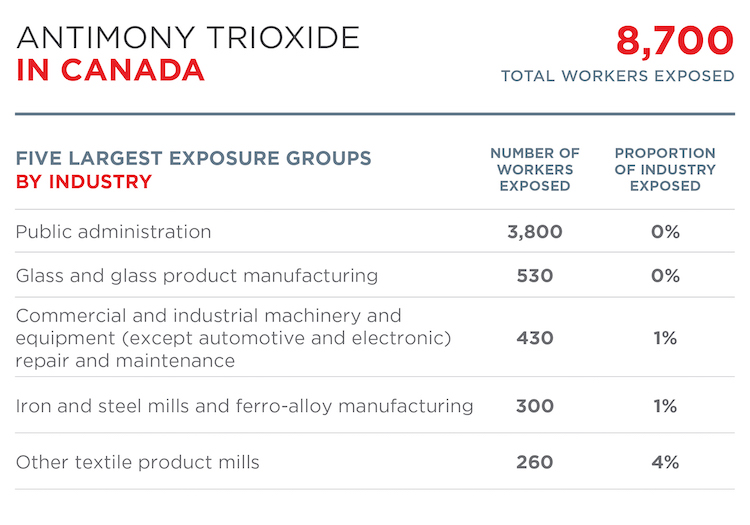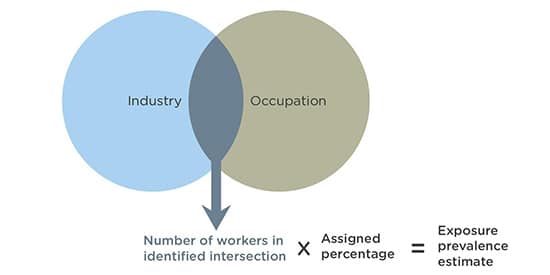Antimony Trioxide Occupational Exposures
Antimony Trioxide Occupational Exposures
Overview
Inhalation is the most important route of occupational exposure, however oral and dermal contact are also a concern.[1] CAREX Canada estimates that approximately 8,700 Canadians are exposed to antimony trioxide in the workplace.
READ MORE...
The primary industrial groups exposed are public administration, followed by glass and glass product manufacturing. In terms of occupations, the largest exposed groups are police officers (exposed in firing ranges), welders and related machine operators, artisans and craftspersons, and glass forming and finishing machine operators and glass cutters.
Other workers likely to be exposed include those involved in: antimony trioxide production; antimony processing, smelting, and packaging of antimony compounds; production of ceramics and alloys that contain Sb2O3; and manufacture and application of flame retardants.[2] Workers in facilities that recycle lead-acid batteries may also be exposed to antimony.[3] Firefighters and other emergency workers may be exposed when materials containing antimony trioxide as a fire retardant combust.[2] Exposures may also occur for workers involved producing PET bottles, where antimony trioxide is used as the main catalyst.
Prevalence Estimate
Results show that 8,700 Canadians are exposed to antimony trioxide in their workplaces; 78% of these workers are male. The largest industrial groups exposed are public administration (where police officers are captured), glass and glass products manufacturing, textile product mills, and plastic product manufacturing.
When exposure is examined by occupation, the largest exposed groups are police officers (exposed in firing ranges, 3,900 workers exposed) and welders and related machine operators (2,400 workers exposed). Other important jobs are artisans and craftspersons (370 workers exposed) and workers in glass forming and cutting (360 workers exposed).
The number of workers exposed to antimony trioxide decreased by approximately 1,000 workers from 2006 to 2016 (an 11% decrease). This was primarily driven by a decrease in the total number of artisans.
Workers exposed to antimony trioxide by industry in 2016

Workers exposed to antimony trioxide by region in 2016
Click the second tab to view total number of workers exposed.
* = < 50 workers
Methods and Data
Our Occupational Approach page outlines the general approach used to calculate prevalence and exposure level estimates for workplace exposures.
Data Sources
Data used in developing the occupational estimates for antimony trioxide were collected from several sources:
- The Canadian Workplace Exposure Database (CWED) contains over 600 measurements for antimony trioxide exposure. These measurements were collected during the years 1981 to 2004 in Ontario and British Columbia workplaces.
- Canadian and US scientific peer reviewed publications that addressed antimony trioxide exposure in Canada and the United States.
- Grey literature including technical reports from governments and international bodies.
Prevalence Estimate Method
CAREX defines exposure to antimony trioxide as inhalation and/or dermal exposure at work to levels above those encountered in the general environment.
To determine the number of workers potentially exposed to antimony trioxide at work, CAREX occupational exposure experts used methods previously established in other peer-reviewed CAREX projects in Europe. A series of steps were taken to assign exposure proportions to occupations and industries at risk of exposure to antimony trioxide.

- Occupations and industries at risk of possible exposure to antimony trioxide were identified using any combination of data sources described above.
- The total number of workers in each identified occupation and industry intersection was obtained from Statistics Canada 2016 census data.
- A percentage of workers exposed was assigned to that occupation and industry intersection. Percentages were determined by consultation with existing evidence in the data sources, previously established methods from the Europe CAREX estimates and the expert judgement of CAREX occupational hygienists.
- The number of workers in the identified group is multiplied by the assigned percentage to calculate the prevalence estimate of workers exposed to antimony trioxide.
Sources
Subscribe to our newsletters
The CAREX Canada team offers two regular newsletters: the biannual e-Bulletin summarizing information on upcoming webinars, new publications, and updates to estimates and tools; and the monthly Carcinogens in the News, a digest of media articles, government reports, and academic literature related to the carcinogens we’ve classified as important for surveillance in Canada. Sign up for one or both of these newsletters below.
CAREX Canada
School of Population and Public Health
University of British Columbia
Vancouver Campus
370A - 2206 East Mall
Vancouver, BC V6T 1Z3
CANADA
As a national organization, our work extends across borders into many Indigenous lands throughout Canada. We gratefully acknowledge that our host institution, the University of British Columbia Point Grey campus, is located on the traditional, ancestral, and unceded territories of the xʷməθkʷəy̓əm (Musqueam) people.



